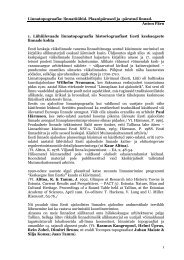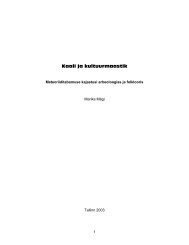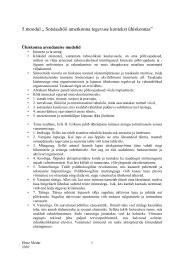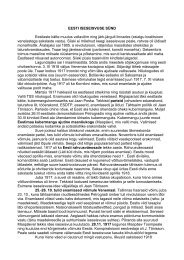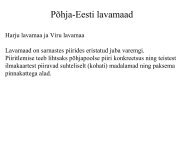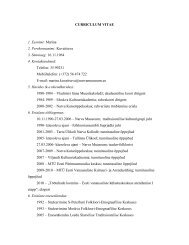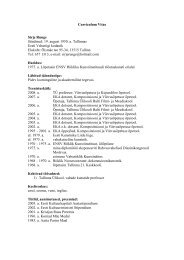crowding and children's mental health: the role of house type
crowding and children's mental health: the role of house type
crowding and children's mental health: the role of house type
Create successful ePaper yourself
Turn your PDF publications into a flip-book with our unique Google optimized e-Paper software.
egulate social interaction. This variable in combination<br />
with higher internaldensity leads to social<br />
withdrawalwhich, in turn, causes poor <strong>mental</strong><br />
<strong>health</strong>. The taller <strong>and</strong> larger a multiple dwelling<br />
complex, <strong>the</strong> greater <strong>the</strong> adverse, symbiotic relations<br />
with residential<strong>crowding</strong>. Scienti¢c validation<br />
<strong>of</strong> <strong>the</strong>se ideas awaits fur<strong>the</strong>r investigation.<br />
Acknowledgements<br />
We thank <strong>the</strong> many children, families <strong>and</strong> teachers<br />
who participated in this research project. We also<br />
acknowledge Annette Roner <strong>and</strong> Elke Roitner-Grabher<br />
for <strong>the</strong>ir assistance in conducting this study.<br />
This research was partially supported by <strong>the</strong> Austrian<br />
Ministry <strong>of</strong> Science <strong>and</strong> Transportation, <strong>the</strong><br />
Austrian^U.S. Fulbright Commission, <strong>and</strong> <strong>the</strong> NationalInstitute<br />
<strong>of</strong> Child Health <strong>and</strong> Human Development,<br />
1F33 HD08473-01.<br />
Notes<br />
Reprint requests <strong>and</strong> correspondence should be addressed<br />
to Gary W. Evans, Cornell university. Design <strong>and</strong> Environ<strong>mental</strong>Analysis,<br />
Ithaca, NY 14853-4401, U.S.A.; e-mail:<br />
gwel@cornell.edu.<br />
1^Education is <strong>the</strong> most commonly used index <strong>of</strong> social<br />
class in epidemiological <strong>and</strong> social science research in<br />
Austria (cf. Lercher & Schmitzberger, 1997). It is not appropriate<br />
to inquire about family income in Austrian society.<br />
For example, no questions about income are<br />
included in <strong>the</strong> Austrian census. In addition to custom<br />
with respect to ¢nancialprivacy, many Austrian mo<strong>the</strong>rs<br />
are working at home as <strong>house</strong>mo<strong>the</strong>rs (greater than half<br />
<strong>of</strong> <strong>the</strong> current sample). Fur<strong>the</strong>rmore, many families are<br />
single-parent heads <strong>of</strong> <strong>house</strong>holds or include cohabitating<br />
but unmarried adults. Moreover, Austrian families <strong>of</strong>ten<br />
provide some ¢nancialsupport for <strong>the</strong>ir children, especially<br />
when <strong>the</strong> children ¢rst move out <strong>of</strong> <strong>the</strong> parental residence<br />
<strong>and</strong> begin <strong>the</strong>ir own families. Data on fa<strong>the</strong>r’s are<br />
not included herein because <strong>of</strong> <strong>the</strong> large proportion <strong>of</strong> single<br />
parent or cohabitating <strong>house</strong>holds in Austria. The relations<br />
among maternaleducation, density <strong>and</strong> <strong>house</strong> <strong>type</strong><br />
are shown above in Table 2. As indicated in <strong>the</strong> text,<br />
mo<strong>the</strong>r’s occupationallevelis unrelated to <strong>house</strong> <strong>type</strong> or<br />
density. We included a statistical control for maternal education<br />
since it is correlated to density.<br />
References<br />
Aiello, J. R. & Baum, A. (Eds) (1979). Residential Crowding<br />
<strong>and</strong> Design. New York: Plenum.<br />
Altman, I. (1975). The Environment <strong>and</strong> Social Behavior.<br />
Monterey, CA: Brooks-Cole.<br />
Baum, A. & Davis, G. (1980). Reducing <strong>the</strong> stress <strong>of</strong> highdensity<br />
living: an architectural intervention. Journal<br />
<strong>of</strong> Personality <strong>and</strong> Social Psychology, 38, 471^481.<br />
Crowding <strong>and</strong> Children’s Mental Health 229<br />
Baum, A. & Paulus, P. B. (1987). Crowding. In D. Stokols &<br />
I. Altman (Eds), H<strong>and</strong>book <strong>of</strong> Environ<strong>mental</strong> Psychology.<br />
New York: Wiley, pp. 533^570.<br />
Baum, A. & Valins, S. (1977). Architecture <strong>and</strong> Social Behavior.<br />
Hillsdale, NJ: Erlbaum.<br />
Baum, A. & Valins, S. (1979). Crowding <strong>and</strong> <strong>the</strong> regulation<br />
<strong>of</strong> socialcontact. In L. Berkowitz (Ed.), Advances in<br />
Experi<strong>mental</strong> Social Psychology, Vol. 12. New York:<br />
Academic, pp. 131^175.<br />
Becker, F. D. (1990). The Total Workplace. New York: van<br />
Nostr<strong>and</strong> Reinhold.<br />
Booth, A. & Edwards, J. (1976). Crowding <strong>and</strong> family relations.<br />
American Sociological Review, 41, 308^321.<br />
Booth, A. & Johnson, D. (1975). The e¡ect <strong>of</strong> <strong>crowding</strong> on<br />
child <strong>health</strong> <strong>and</strong> development. American Behavioral<br />
Scientist, 18, 736^749.<br />
Bradley, R. H. & Caldwell, M. (1984). The HOME inventory<br />
<strong>and</strong> family demographics. Develop<strong>mental</strong> Psychology,<br />
20, 315^320.<br />
Bronfenbrenner, U. & Morris, P. (1998). The ecology <strong>of</strong> develop<strong>mental</strong><br />
processes. In W. Damon & R. Lerner<br />
(Eds), H<strong>and</strong>book <strong>of</strong> Child Psychology, Vol. 1. New York:<br />
Wiley, pp. 993^1028.<br />
Bullinger, M., von Mackensen, S. & Kirchberger, I. (1994).<br />
KINDL-Ein fragebogen zur erfassung der gesundheitsbezogenen<br />
lebensequalitat von kindern. Zeitschrift<br />
fˇr Gesundheitspsychologie, 11, 64^77.<br />
Bullinger, M. & Ravens-Sieberer, U. (1995). Health related<br />
quality <strong>of</strong> life assessment in children. European Review<br />
<strong>of</strong> Applied Psychology, 45, 245^254.<br />
Cohen, J. (1988). Stastical Power Analysis for <strong>the</strong> Behavioral<br />
Sciences (4th edn.). Hillsdale, NJ. Erlbaum.<br />
Cox, V., Paulus, P. B., McCain, G. & Karlovac, M. (1982).<br />
The relationship between <strong>crowding</strong> <strong>and</strong> <strong>health</strong>. In A.<br />
Baum & J. E. Singer (Eds), Advances in Environ<strong>mental</strong><br />
Psychology, Vol. 4. Hillsdale, NJ: Erlbaum, pp. 271^294.<br />
Edwards, J., Fuller, T., Sermsri, S. & Vorakitphokatorn, S.<br />
(1990). Chronic stress <strong>and</strong> psychological well being.<br />
World Congress <strong>of</strong> Sociology, Madrid.<br />
Evans, G. W. (2001). Environ<strong>mental</strong>stress <strong>and</strong> <strong>health</strong>. In<br />
A. Baum, T. Revenson & J. E. Singer (Eds), H<strong>and</strong>book<br />
<strong>of</strong> Health Psychology. Mahweh, NJ: Erlbaum, pp. 365^<br />
385.<br />
Evans, G. W. & Lepore, S. J. (1997). Moderating <strong>and</strong> mediating<br />
processes in environment behavior research. In<br />
G. T. Moore & R. W. Marans (Eds), Advances in Environment,<br />
Behavior, <strong>and</strong> Design, Vol . 4. New York:<br />
Plenum, pp. 255^285<br />
Evans, G. W., Lepore, S. J., Sejwal, B. & Palsane, M. N.<br />
(1998). Chronic residential<strong>crowding</strong> <strong>and</strong> children’s<br />
well being: an ecological perspective. Child Development,<br />
69, 1514^1523.<br />
Evans, G. W., Lepore, S. J. & Schroeder, A. (1996). The <strong>role</strong><br />
<strong>of</strong> interior design elements in human responses to<br />
<strong>crowding</strong>. Journal <strong>of</strong> Personality <strong>and</strong> Social Psychology,<br />
70, 41^46.<br />
Evans, G. W., Kliewer, W. & Martin, J. (1991). The <strong>role</strong> <strong>of</strong><br />
<strong>the</strong> physical environment in <strong>the</strong> <strong>health</strong> <strong>and</strong> well being<br />
<strong>of</strong> children. In H. Schroeder (Ed.), New Directions in<br />
Health Psychology Assessment. Washington, DC: Hemisphere<br />
Press, pp. 127^157.<br />
Evans,G.W.,Maxwell,L.M.&Hart,B.(1999).Parental<br />
language <strong>and</strong> verbal responsiveness to children in


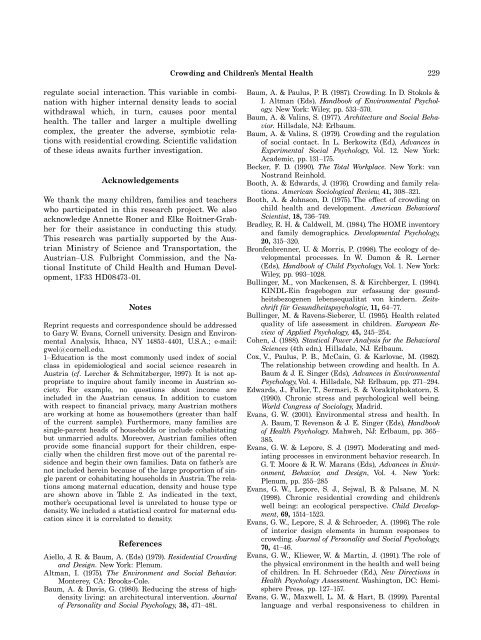
![5 Verben 2 S[1]. 35-44.pdf](https://img.yumpu.com/27096544/1/184x260/5-verben-2-s1-35-44pdf.jpg?quality=85)

